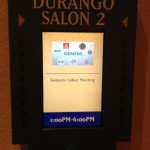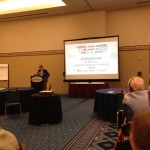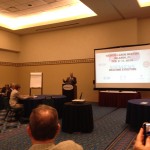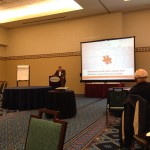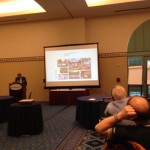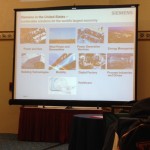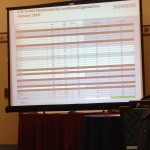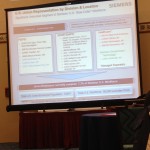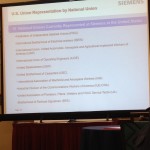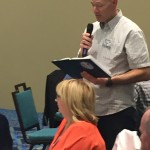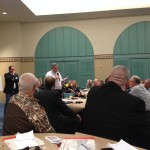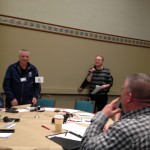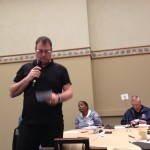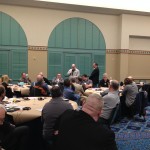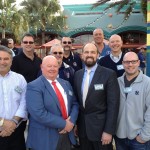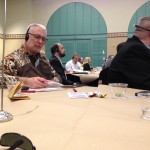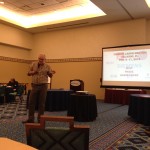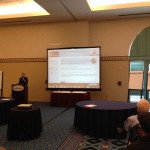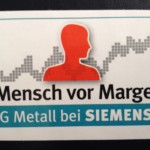2016 Siemens Labour Meeting
- 2016 Siemens Labour Meeting Venue
- Meeting hall
- Reinhald Hahn welcomes participants
- Randy Middleton welcomes all participants
- Robert Kensbock, Deputy Chairman of the Central Works Council at Siemens in Germany, discusses current situation of Siemens in Germany
- Lee Vickers, Siemens US HR Senior Director discusses current situation
- Siemens Industries
- US Union distribution
- Only 7.3% of the 50 000 Siemens employees in the US are unionized
- 10 Unions currently represent US Siemens workers
- Brother George Zoni addresses the hall.
- Brother Claude Boisvert speaks at the conference
- Dirk Linder introduces a participant
- Brother Luc Frigon speaks at the conference
- Brother Fred Labelle addresses the hall
- The IAMAW members of the 2016 Siemens Labour Meeting
- Members listen to German translation
- Closing statements by Lela Klein and Jerry Kurimski
- Closing statment by Harald Kern
- Closing statement by Dirk Linder
- People Before Profits
This event represents the first time LL2468 has participated in a Siemens Union Conference. Members from IG Metall, IBEW (International Brotherhood of Electrical Workers), IAMAW, IUE-CWA (International Union of Electronic, Electrical, Salaried, Machine and Furniture Workers – Communications Workers of America), USW (United Steel Workers), UAW (United Auto Workers) and UNIFOR were representing Germany, Canada and the US. Canadians were represented by an all-Quebec contingent from Montreal, Quebec City, Trois-Rivieres and Drummondville.
Reinhard Hahn, IG Metall Head of Projects, stated that a major fact of Germany’s success is the inclusion of Labour Unions in all levels of the Company Hierarchy. Economic profitability is intertwined with employees. The German model is based upon a 3-Pillar system: The Trade Union, The Works Council and The Supervisory Board.
IG Metall spearheaded a movement to introduce an International Framework Agreement for all Siemens companies throughout the world. Included in this plan is a Neutrality Clause that would allow for organization opportunities of non-organized Siemens shops with no interference from Company management. At present, this is still not recognized in Canada and the US.
Lee Vickers, Senior Director of Siemens HR in the US spoke about the current situation of Siemens in the US, including Union representation and the various Siemens divisions. When questioned about the applicability of any neutrality clause in the US, he answered that he thought that it wouldn’t work in the US. He also mentioned that it’s up to the employees to organize on their own.
The main activity that occurred at this meeting was the World Café, the purpose of which was to gather answers to the following questions: 1. What would be high value for the unions active in Siemens companies? 2. How should the structure of inter-union representation at Siemens be defined? 3. What programs should be agreed with Siemens? Framework of apprentice and training programs defined? 4. Most important parts with respect to activities in Siemens companies in the US? What would be most esteemed by employees? 5. How should communications/coordination be defined between all parties?
Many interesting conclusions were revealed following the dissemination of the answers, but the returning themes revolved around job security, pensions, healthcare, right to respect/dignity and fair representation. Other items such as forming union groups according to industry and/or geography, forming email lists and websites and ensuring that appropriate interpretation is available were also listed.
We look forward to attending future Siemens Labour Meetings.
Links to the meeting from other unions:
https://www.flickr.com/photos/uswdistrict4edison/albums/72157664576961176/page2
http://www.dialog.igmetall.de/international/news/view/datum/2016/02/22/titel/workshop-of-us-and-canadian-unions-represented-at-Siemens/


